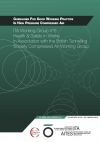This document sets out guidance on good practice in high pressure compressed air work. Guidance is given in the form of recommendations and consequently has a lower standing than regulation or standards. The guidance given aims to be goal setting in nature rather than prescriptive. However, because of the lack of alternative sources of published information or standards on HPCA work, some of the recommendations given are fairly detailed. Often in hyperbaric work there are no absolute rights or wrongs. Users of this guidance are free to adopt their own solutions however these should not be less safe than the recommendations in this document. For many limits quoted, such as maximum gas exposure limits, the recommended values given have been arrived at over a period as the consensus of expert opinion within the hyperbaric community. Means of achieving set goals have been given in some cases, however other equally valid means of achieving the same goals can exist and it is down to the experience of the reader to select the (more) most appropriate. Likewise, not all hyperbaric situations have been covered and the reader should use discretion and experience in determining the appropriateness of applying or interpolating between recommendations given in the text. Regulators should be wary of enforcing these guidelines in an overly prescriptive manner as this may stifle innovation and creativity, resulting in a less safe outcome overall. Often in hyperbaric work it is not possible to guarantee absolute safety and in these cases it is the relative safety of proposals which should be considered. Likewise, the inter and intra-individual variation in response to pressure exposure should be considered. Isolated or unexpected cases of decompression illness should always be considered a negative outcome but may be an indicator of personal susceptibility rather than of deficiencies in a decompression regime. One major addition over revision 1 is the coverage of saturation techniques. To many people, saturation presents a psychological barrier beyond which they will not pass. We should perhaps remember that for most people, life is one long saturation exposure to air at atmospheric pressure. Why then should saturation at higher pressures present such an insurmountable mental obstacle? Saturation if done safely removes much of the health risk associated with the multiple decompressions required to achieve the same productive working time from non-saturation exposures even at low pressures. The use of heliox eliminates the narcotic risk from breathing high pressure nitrogen and significantly reduces the work of breathing. With helium reclaim, it is an environmentally sound option. Full advantage should be taken of favourable gas properties when devising exposure and decompression procedures.
Guidelines for good working practice in high pressure compressed air Version 2018
Download document


